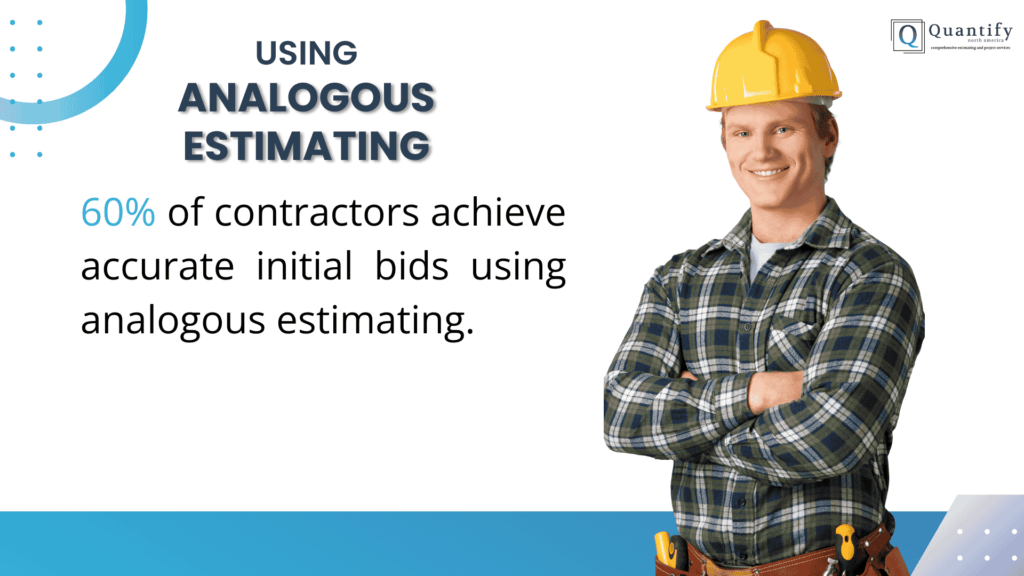Getting the right estimate of any intended job can directly impact your bottom line. Accurate estimating is crucial for project management in industries like construction. Inadequate estimating can lead to stretching resources too thin or not being able to complete the job.
To ensure reliability, contractors use various estimation strategies, including analogous estimating. Jobs completed with analogous estimating use past experiences to create optimal estimates. Let’s examine this strategy more closely.
What Is Analogous Estimating?
Analogous estimating uses data from previous similar projects to determine the time, cost, and resources needed for new projects. It relies on experience as a foundation for making calculations; you know what they say, “Been there, done that.”
This method is appreciated for not having so many complex math or exhaustive breakdowns involved. It is useful for fast delivery of estimates and can be done by anyone who has been in service for a while.
How Analogous Estimating Works in Construction
For specialists in trades like flooring, drywall, or painting, the process typically looks like this:
- Find a similar past project – You dig through your records for a job with comparable scope and complexity.
- Pull the relevant numbers – You look at what that project actually cost, how long it took, and what resources you used.
- Make adjustments for differences – You factor in things like location, current material prices, or specific requirements for the new job.
- Create your estimate – Based on your adjusted historical information, you put together numbers for the new project.
Analogous vs. Parametric Estimating: A Brief Comparison
While analogous estimating relies on overall project similarity and expert judgment, parametric estimating takes a more mathematical approach using statistical relationships and unit costs (like price per square foot).
Analogous estimation shines during early project stages when detailed information might be lacking, while parametric estimating works better when you can break projects down into well-defined, measurable units.
Both methods have their place in a contractor’s toolkit, and there are many comparison criteria between them. However, in a nutshell, many professionals use analogous for quick preliminary estimates and parametric for more refined proposals.
When to Use Analogous Estimating in Your Contracting Business

Analogous estimating works best in specific situations that contractors face regularly:
1. Early Budget Discussions and Feasibility Checks
Analogous estimation assists in providing initial ballpark values for budget allocation before deep research is carried out. This directly gives an idea if the process is worth it or can be put in motion.
2. Incomplete Project Information
During initial project talks, you rarely have final specs or complete drawings. Analogous estimating fills these gaps by drawing on your experience with similar work.
3. Tight Time Constraints
When you’ve got multiple bid opportunities on your desk, you can’t spend days developing each estimate. Analogous estimation gives you a reliable shortcut that delivers reasonable accuracy.
4. Fast Proposal Development
For smaller jobs or repeat clients, analogous estimating helps you turn around proposals quickly, making your company more responsive and potentially winning more work.
Advantages of Analogous Estimating for Contractors
For busy contractors handling multiple projects and bids, analogous estimating offers several clear benefits:
1. Speed and Efficiency
Using your existing knowledge lets you produce estimates much faster than building them from zero. This matters when you’re responding to several bid opportunities at once.
2. Lower Overhead Costs
People often overlook the cost of an estimate itself. Detailed takeoffs require significant staff time. Analogous estimating cuts this overhead, allowing your team to submit more bids without expanding your staff.
3. Works Well With Limited Information
Early in project discussions, when plans might be rough drafts and specifications vague, analogous estimating provides reasonable numbers based on experience rather than precise measurements.
4. Makes Your Experience Count
This approach rewards your accumulated knowledge and project history, turning years in the business into a competitive edge.
Limitations and How to Overcome Them
While analogous estimating helps in many situations, it comes with some challenges:
1. Accuracy Concerns
Limitation: Estimates may lack the precision of detailed takeoffs.
Solution: Use analogous methods for initial budgets, then refine with more detailed approaches as the project develops. For critical bids, consider finding a subcontractor or service to handle detailed estimates.
2. Dependency on Similar Projects
Limitation: You need relevant past projects as reference points.
Solution: Keep a detailed database of completed projects with notes about unique factors. If you have no prior experience, you can hire agencies that provide comprehensive estimating services in your area.
3. Subjective Elements
Limitation: Different team members might choose different “similar” projects.
Solution: Create standard guidelines for project comparison and review estimates as a team to align judgments.
Best Practices for Implementing Analogous Estimating

To get the most from analogous estimating in your contracting business, take these actions:
1. Document Everything
Build a structured database of completed projects with detailed information on costs, timelines, materials, and special circumstances. Better historical data leads to more accurate analogous estimates.
2. Define What “Similar” Means
Create clear definitions of what makes projects comparable in your specific trade. Flooring contractors might focus on substrate conditions and floor types; painters might care more about surface preparation and access issues.
3. Standardize Your Adjustments
Develop consistent adjustment factors for common variables like inflation, seasonal differences, or location-specific costs. This brings consistency to what could otherwise be very subjective.
4. Mix Methods When Needed
Use analogous estimating for quick preliminary numbers, then back them up with parametric estimating or detailed takeoffs for final proposals on larger projects.
5. Learn From Results
After completing projects, compare your analogous estimates against actual costs and analyze any gaps. This feedback loop will sharpen your estimation accuracy over time.
Real-World Examples of Analogous Estimating in Construction
Here’s how analogous estimating plays out in daily operations for different specialty contractors:
Example 1: Flooring Contractor
Scenario: A property manager needs an estimate for carpet replacement in a 10,000-square-foot office.
Analogous Estimation Process:
- The estimator remembers a similar office carpet job from earlier this year in a comparable building.
- The similar job was an 8,500-square-foot project that cost $42,500 (about $5 per square foot).
- Material costs have gone up about 5% since then.
- After adjusting for size and cost increases: 10,000 sq ft × $5 × 1.05 = $52,500
- The proposal goes out at $52,500, backed by recent, relevant experience.
Example 2: Drywall Contractor
Scenario: A restaurant owner requires a drywall installation at a new 2,200-square-foot location.
Analogous Estimation Process:
- The contractor database shows a 2,500-square-foot drywall installation at a restaurant last year.
- That job cost $22,500 for labor and materials.
- The new project has fewer walls but needs the same fire-rated drywall.
- Based on these factors, the contractor estimates $19,800 for the new job.
Example 3: Painting Contractor
Scenario: A homeowner association wants an estimate for exterior painting of a 12-unit condo complex.
Analogous Estimation Process:
- The painter recently finished an exterior job for a 10-unit complex with similar architecture.
- That project ran $38,000.
- The new complex has 20% more painted surface but less detailed trim work.
- After adjusting for these differences, the contractor quotes $44,000.
Is Analogous Estimating Right for Your Business?
There is no one-size-fits-all. Some jobs do well with analogous while others could require another estimation technique or even a combination.
For mid-sized commercial contractors in specialized trades, analogous estimating serves as a valuable tool in your estimation arsenal. It lets you tap into your experience and respond quickly to opportunities without sacrificing reasonable accuracy.
The quality of your historical data and the experience of your team ultimately determine your estimation success, regardless of method. You can reach out to estimation and project management services who have years of experience in this field, for a safer and more time-effective way to sort estimations.
Strategic use of analogous estimating helps contractors win more bids, cut costs, and increase profits.
Frequently Asked Questions About Analogous Estimating
- How accurate is analogous estimating?
Analogous estimating helps give a good rough estimate depending on the past information you have. If it is for initial bids and ballpark figures, it is very effective. You can then use other detailed methods to refine your value later.
- Can I use analogous estimating without experience?
Without having historical data of your own, you can make use of external data from businesses within your area. However, in such cases, it is best to make use of other estimating methods or hire estimating services like Quantify North America.
- How do I avoid ‘scope creep’ when using analogous estimating?
Scope creep (gradual expansions and additions to the original project plan) is a real danger with any estimating method. The best defense is to define the scope of the new project as clearly as possible before you even start looking for comparable past projects. Consider all possible additions before you give your estimate, and that includes contingencies.




